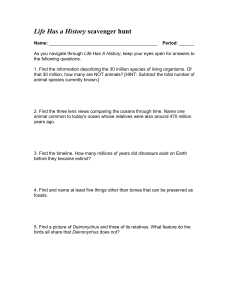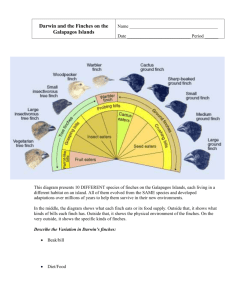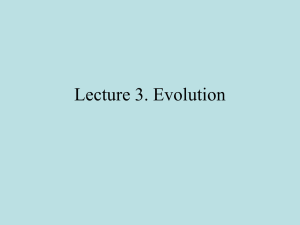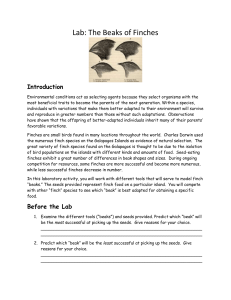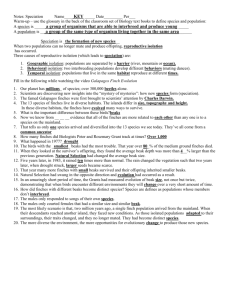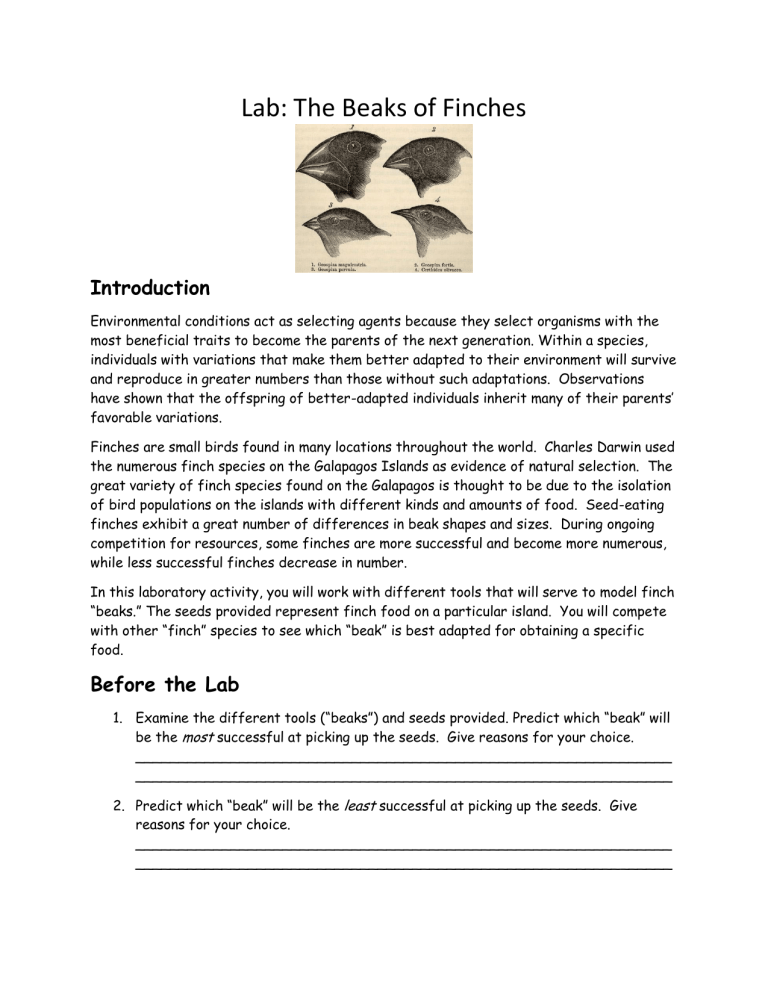
Lab: The Beaks of Finches Introduction Environmental conditions act as selecting agents because they select organisms with the most beneficial traits to become the parents of the next generation. Within a species, individuals with variations that make them better adapted to their environment will survive and reproduce in greater numbers than those without such adaptations. Observations have shown that the offspring of better-adapted individuals inherit many of their parents’ favorable variations. Finches are small birds found in many locations throughout the world. Charles Darwin used the numerous finch species on the Galapagos Islands as evidence of natural selection. The great variety of finch species found on the Galapagos is thought to be due to the isolation of bird populations on the islands with different kinds and amounts of food. Seed-eating finches exhibit a great number of differences in beak shapes and sizes. During ongoing competition for resources, some finches are more successful and become more numerous, while less successful finches decrease in number. In this laboratory activity, you will work with different tools that will serve to model finch “beaks.” The seeds provided represent finch food on a particular island. You will compete with other “finch” species to see which “beak” is best adapted for obtaining a specific food. Before the Lab 1. Examine the different tools (“beaks”) and seeds provided. Predict which “beak” will be the most successful at picking up the seeds. Give reasons for your choice. ______________________________________________________________ ______________________________________________________________ 2. Predict which “beak” will be the least successful at picking up the seeds. Give reasons for your choice. ______________________________________________________________ ______________________________________________________________ Directions You will be trying to transfer the seeds from the island (the tray) into your stomach (the petri dish.) We will do this several times. Each time, your finch must eat at least 15 seeds. If you do not eat 15 seeds during the round, then your finch dies. If your finch dies, you must be reborn as a new finch. Any finch that survives can reproduce and give you a beak of their type. During the first trial, only one student will be eating from each tray. However, during the second trial (the next year) there is a drought. Because of this, there is less food available for the birds! In this trial, two students will be eating from each tray. The next year is even worse!! This time, three students will be eating from each tray. Data What tool is your beak? Your Data How many seeds did you eat during the trial? Did your finch live? Round One: Round Two: Round Three: 1. Was your original beak successful? ______________________________ 2. If so, what made it successful? If not, what made it unsuccessful? ______________________________________________________________ ______________________________________________________________ ______________________________________________________________ Class Data Tool Type How Many Were Alive at the Beginning? How Many were Alive after Round One? How Many were Alive after Round Two? How Many Were Alive After Round Three? Analysis 1. Looking at the chart above, which beak type was the best at surviving? _________________________________________________________ 2. Looking at the chart above, which beak type was the worst at surviving? _________________________________________________________ 3. After a million years, which beak type would you expect the birds to have? _________________________________________________________ Why? ___________________________________________________ _________________________________________________________ _________________________________________________________. 4. Name three traits other than beak characteristics that could contribute to the ability of a finch to compete successfully. a.________________________________________________________ b.________________________________________________________ c.________________________________________________________ . 5. Were the beaks that were successful in the first trial still successful once we added competition? Why or why not? _________________________________________________________ _________________________________________________________ . 6. Why were there fewer survivors at the end of round three? _________________________________________________________ _________________________________________________________ Use the following chart to answer the remaining questions. 7. Predict which species of finch would be most likely to survive if the weather on the Galapagos Islands gradually changed and the seeds available to the finches became larger with heavier coverings. Support your answer with an explanation. ________________________________________________ _________________________________________________________ _________________________________________________________. 8. One island is populated by two species— small ground finches and small tree finches. a. What two types of food would you expect to be available on this island? Support your answer. ______________________________ ____________________________________________________ ____________________________________________________ b. Would you expect the two species to compete for food on this island? Support your answer. ___________________________________ ____________________________________________________ ____________________________________________________ c. How might the two native finch populations be affected if several dozen sharp-billed ground finches were to migrate to the island and survive? Support your answer. _____________________________ ____________________________________________________ ____________________________________________________. 9. Explain how an island could support large populations of both large ground finches and small ground finches. ________________________________ _________________________________________________________ _________________________________________________________ . 10. Would you expect an island to be able to support large populations of both small ground finches and sharp-billed ground finches? Why or why not? (HINT: your answer should include the word “competition.”) _________________________________________________________ _________________________________________________________ _________________________________________________________ 11. What has this lab taught you about evolution that you didn’t know before? _________________________________________________________ _________________________________________________________ _________________________________________________________
